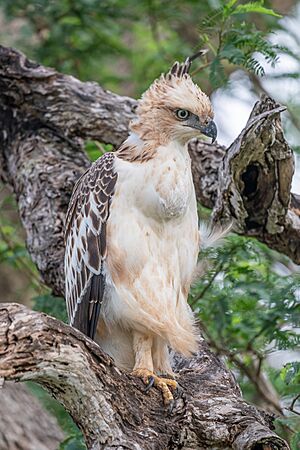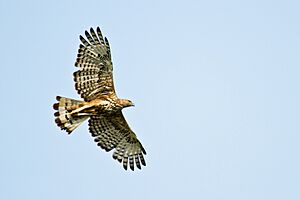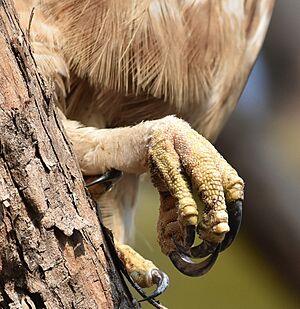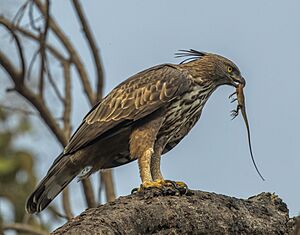Changeable hawk-eagle facts for kids
Quick facts for kids Changeable hawk-eagle |
|
|---|---|
 |
|
| in Bandipur National Park | |
| Conservation status | |
| Scientific classification | |
| Genus: |
Nisaetus
|
| Species: |
cirrhatus
|
| Subspecies | |
|
|
| Synonyms | |
|
Spizaetus cirrhatus |
|
The Changeable Hawk-Eagle (Nisaetus cirrhatus), also known as the Crested Hawk-Eagle, is a large bird of prey. It belongs to the family called Accipitridae, which includes eagles, hawks, and kites. This eagle is known for its special feathers that cover its lower legs, a feature found in many eagles from tropical areas.
It used to be placed in a different group of eagles, but scientists found that it was better suited to the Nisaetus genus. The Changeable Hawk-Eagle is a typical "hawk-eagle" because it's a quick hunter that lives in forests. Like many eagles, it eats different kinds of animals, including birds, mammals, and reptiles. This eagle is the most widespread and adaptable species in its group. Its name "changeable" comes from the wide variety of colors and patterns its feathers can have, which change with age and when it sheds old feathers.
Contents
About the Changeable Hawk-Eagle
Naming and History
The Changeable Hawk-Eagle was first officially described in 1788 by a German scientist named Johann Friedrich Gmelin. He gave it the scientific name Falco cirrhatus. The name Nisaetus comes from old words meaning "sparrowhawk" and "eagle." The word cirrhatus means "curly-headed" in Latin, referring to its crest.
This eagle's classification has been a bit tricky. Scientists have studied its DNA to understand its family tree better. They found that some hawk-eagles from the "Old World" (like Asia) were different from those in the "New World" (like the Americas). So, the Changeable Hawk-Eagle and nine other species were moved to the Nisaetus group.
There are two main types of Changeable Hawk-Eagles: one group has a crest (a tuft of feathers on its head), and the other has little to no crest. Some populations also have "dark morphs," meaning they are much darker in color.
Different Types of Changeable Hawk-Eagles
There are several subspecies, which are like different regional versions of the same species.
Crested Changeable Hawk-Eagle Group
- N. c. cirrhatus (Gmelin, JF, 1788): This is the main subspecies found in India. It's usually pale brown on top and has dark streaks below. It has a long crest, often 10 to 14 cm (3.9 to 5.5 in) long, which is why it's also called the Crested Hawk-Eagle. It's one of the larger types. Males have a wing length of 405 to 442 mm (15.9 to 17.4 in), and females are 448 to 462 mm (17.6 to 18.2 in).
- N. c. ceylanensis (Gmelin, JF, 1788): This type lives only in Sri Lanka. It also has a long crest, similar to the Indian type. It's a bit smaller than the Indian subspecies. Males have a wing length of 351 to 370 mm (13.8 to 14.6 in), and females are 353 to 387 mm (13.9 to 15.2 in).
Crestless Changeable Hawk-Eagle Group

- N. c. limnaeetus (Horsfield, 1821): This is the most widespread subspecies, found from the Himalayas to Southeast Asia, including the Philippines and Sunda Islands. It's known for its many color variations (polymorphism), which is why the species is called "changeable." It can be pale, intermediate, or dark brown. Some birds in this group have a very small crest, only 1 to 3 cm (0.39 to 1.18 in) long, while many have no crest at all. Its size varies a lot depending on where it lives, with the largest ones found in the Himalayan foothills. Males have a wing length of 380 to 430 mm (15 to 17 in), and females are 405 to 462 mm (15.9 to 18.2 in).
- N. c. andamanensis (Tytler, 1865): This subspecies lives in the Andaman Islands. It's darker than the Indian type but doesn't usually have a full dark morph. It's a small subspecies. Males have a wing length of 330 to 375 mm (13.0 to 14.8 in), and females are 358 to 377 mm (14.1 to 14.8 in).
- N. c. vanheurni (Junge, 1936): Found on Simeulue Island, this is the smallest accepted subspecies. It looks similar to N. c. limnaeetus but doesn't have a dark morph and never has a crest. A single male had a wing length of 312 mm (12.3 in).
What They Look Like
The Changeable Hawk-Eagle is a large but slim eagle. Females are bigger than males, usually by about 7%. Their total length can be up to 77 cm (30 in). In the Philippines, males weigh about 1.36 kg (3.0 lb) and females about 1.6 kg (3.5 lb).

Adult eagles are usually dark brown on top and have bold streaks on their underside. They have a strong beak, a tail with thin bars, and long feathered legs. They often sit very upright on branches. When perched, their wings only reach about halfway down their tail.
Pale morph adults are mostly dark brown with faint lighter edges on their wings. Their head and neck are streaked with black, and they have a blackish crest if present. Their tail is lighter brown with a white tip and a broad black band. Their underside is white to buff with bold black or dark brown streaks.
Some subspecies, especially N. c. liminaeetus, can also have an intermediate or dark morph. Intermediate morphs are grey-brown underneath with less clear streaking. Dark morph adults are almost entirely dark chocolate brown to black.
Young Changeable Hawk-Eagles (juveniles) are dark brown on top but have much more white on their back and wings. Their tail is light brown with about seven thin dark bars. Their head and underside can vary, from buff with a black-tipped crest to almost entirely whitish. Young birds are often spotted or streaked with black. They get their full adult feathers around their fourth year.
Adult eagles have yellow to orange-yellow eyes, while young ones have grey-brown to pale greenish eyes. All ages have yellow feet.
In Flight
In flight, the Changeable Hawk-Eagle has a noticeable head, short, broad, rounded wings, and a long, somewhat square tail. They fly quickly and gracefully, with powerful, shallow wing beats followed by glides. When soaring, they hold their wings slightly lowered or level. Pale morph adults have dark brownish or whitish undersides on their wings. Their flight feathers often have blackish bars. Dark morphs are blackish-brown all over, but the base of their tail and some flight feathers are a lighter grey. Young eagles show large white streaks or spots when flying.
Voice
The Changeable Hawk-Eagle is usually quiet, but during breeding season, it calls loudly from its perch or while flying. Its calls are high-pitched screams, often described as yeep-yip-yip-yip or kwip-kwip-kwip-kwee-ah. In India and Sri Lanka, the call is a slightly different ki-ki-ki-ki-ki-ki-ki-keee, starting short and ending in a long scream.
Similar Birds
The Changeable Hawk-Eagle is usually the most common hawk-eagle in its range. It can be confused with other hawk-eagles, but other species often have broader wings, shorter tails, and different patterns. Young birds are harder to tell apart, but the Changeable Hawk-Eagle usually has more white showing. Other hawk-eagles like the Mountain Hawk-Eagle are larger, while some like Wallace's Hawk-Eagle are smaller.
Some other birds, like the Crested Honey Buzzard, might look similar. However, honey buzzards have smaller heads and longer, narrower wings. The Black Eagle, which is also dark, is much longer-winged and has a uniformly dark tail.
Where They Live and Their Home
The Changeable Hawk-Eagle lives across a huge area, including much of India and Southeast Asia. You can find them in countries like Sri Lanka, Nepal, Bhutan, Myanmar, Thailand, Malaysia, and the Philippines. In India, they are found almost everywhere from the southern tip to the northern plains.
These eagles usually stay in one place and don't migrate. They can live in many different places, like savannah woodlands, farms with trees, areas near water, tea plantations, and even the edges of towns. They also live in evergreen and deciduous forests, as well as secondary forests (forests that have grown back after being cut down) and wetlands. They can be found from sea level up to 2,200 m (7,200 ft) high, but mostly below 1,500 m (4,900 ft).
How They Live

Changeable Hawk-Eagles are comfortable in many types of wooded areas. Like other forest raptors, they have a long tail, short, broad wings, and strong, long legs. These features help them move quickly and strike prey in dense forests. They are called "hawk-eagles" because they hunt like true hawks.
They are very opportunistic hunters, meaning they will eat whatever prey they can find. They are mainly ambush predators, meaning they hide in trees and then pounce quickly on their prey, usually on the ground. They also hunt from perches, flying from branch to branch and looking for prey.
What They Eat
Changeable Hawk-Eagles eat a variety of animals, including birds, mammals, and reptiles. While many of their prey items are relatively small, they are also known to take very large prey, sometimes even bigger than themselves!
In some parts of India, they prefer birds, but they also eat many reptiles and mammals. In West Java, reptiles make up most of their diet, followed by birds and mammals.
Some of the smaller prey they eat include Indian chameleons, Oriental garden lizards, other lizards, common mynas, and palm squirrels. They also hunt larger birds like red junglefowl and other gamebirds, such as peafowl and francolins.
They can take surprisingly large mammals, including hispid hares (which can weigh 2.35 kg (5.2 lb)), Indian hares (up to 2.7 kg (6.0 lb)), and Indian flying foxes (1.3 kg (2.9 lb)). They have even been known to hunt young Old World monkeys, including macaques and langurs, some of which can weigh up to 6 kg (13 lb). There are also reports of them attacking and killing domestic cats (mostly kittens) and even a large adult jungle cat (around 7.3 kg (16 lb)). They might also hunt young Indian gazelles and large monitor lizards.
They have been seen trying to hunt very large birds like adult Indian peafowl (up to 4 kg (8.8 lb)). Sometimes, they also eat dead animals (scavenge) from carcasses of deer and monkeys.
Living with Other Raptors
Changeable Hawk-Eagles often live in the same areas as other large raptors like the Crested Serpent Eagle and the Crested Honey Buzzard. They seem to get along well, perhaps because they each have different hunting styles and diets.
These eagles are usually at the top of the food chain in their habitat, acting as an apex predator. They can live alongside larger eagles like the Mountain Hawk-Eagle by focusing on different types of prey, such as reptiles and birds, rather than mainly mammals. They also live near the much larger Philippine Eagle but likely hunt smaller prey to avoid conflict.
Breeding and Family Life
Changeable Hawk-Eagles are usually solitary, but during breeding season, they form pairs that often stay together for life. They perform amazing aerial displays to defend their territory. The male, and sometimes the female, will fly up vertically, then dive down, sometimes even doing a loop-the-loop in the air while calling loudly.
The breeding season varies by location. In southern India, it's from November to May. In Sri Lanka, it's similar but can last until June. In the warmer Sunda Islands, they can lay eggs almost any time of the year, but mostly between February and August.
They build a large stick nest, often 95 to 105 cm (37 to 41 in) across and 35 to 120 cm (14 to 47 in) deep. Some nests can be very big, up to 1.3 m (4 ft 3 in) wide inside. They line the nest with green leaves. Both parents help build and repair the nest. Nests are usually built high up in large trees, from 6 to 50 m (20 to 164 ft) off the ground, often near a stream or a place with a good view.
The female usually lays only one egg. The egg is white, rough, and may have faint reddish spots. The female incubates the egg for about 40 days. After the chick hatches, the female stays with it for about 25 days, keeping it warm.
A young eagle grows quickly. By 4 to 5 weeks old, it can preen itself and flap its wings. When it's about 52 days old, the eaglet is fully grown, but it doesn't leave the nest until about 60–68 days old. The parents continue to feed it for some time after it leaves the nest. The entire breeding process, from egg-laying to the young eagle leaving the nest, can take about 112 days.
Conservation Status
The Changeable Hawk-Eagle lives across a huge area, covering over 13 million square kilometers. This species is very adaptable, even more so than other eagles in its group. While many other hawk-eagle species have suffered from deforestation and are now Endangered species, the Changeable Hawk-Eagle has been able to survive and even thrive in areas where forests have been cut down or changed.
This eagle can live in many different types of habitats, including areas near human settlements. However, it still needs tall trees and enough prey to survive. Complete deforestation is the biggest threat to this species. Sometimes, they hunt chickens, which can lead to people persecuting them in some areas of India. Overall, their population is stable or even increasing in many places.
Images for kids
-
Image name.image extension
image_caption







